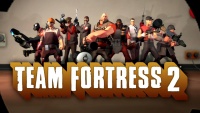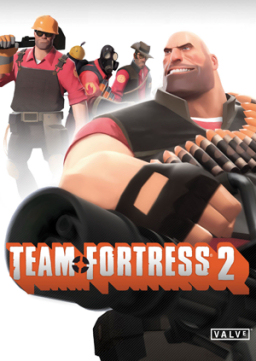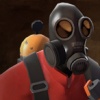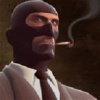Difference between revisions of "Team Fortress 2"
(Adding new content: flaming) |
|||
| Line 15: | Line 15: | ||
|URLTEXT=http://www.teamfortress.com/ | |URLTEXT=http://www.teamfortress.com/ | ||
}} | }} | ||
| − | '''Team Fortress 2''' is a first-person shooter for [[Wikipedia:Windows|Microsoft Windows]], [[Wikipedia:OSX|Mac OSX]], [[Wikipedia:Xbox|Xbox 360]], and [[Wikipedia:Playstation 3|Playstation 3]] created by [[Wikipedia:Valve|Valve Corporation]] using the [[Wikipedia:Source|Source]] game engine. Originally packaged as part of the ''Orange Box''<ref name="Orange Box">''"Orange Box"'' https://store.steampowered.com/sub/469/</ref>, Team Fortress 2 would become a standalone game on April 9, 2008 and then later as a free-to-play game on June 23, 2011 <ref> Team Fortress http://www.teamfortress.com</ref>. Presently, Team Fortress 2 is distributed online through the [[Wikipedia:Steam_(software)|Steam]] platform. The game has been very well received with scores of 92% on [[Wikipedia:Metacritic|Metacritic]]<ref>http://www.metacritic.com/game/pc/team-fortress-2</ref>, 95.8% on [[Wikipedia:GameRankings|GameRankings]]<ref>http://www.gamerankings.com/pc/437678-team-fortress-2/index.html</ref>, and an A on [[Wikipedia:1up.com|1UP]]<ref>http://www.1up.com/games/pc/team-fortress-2/</ref>. Team Fortress 2 became one of the first major games, not including MMORPGSs<ref name="mmorpg">''"MMORPG"'' | + | '''Team Fortress 2''' is a first-person shooter for [[Wikipedia:Windows|Microsoft Windows]], [[Wikipedia:OSX|Mac OSX]], [[Wikipedia:Xbox|Xbox 360]], and [[Wikipedia:Playstation 3|Playstation 3]] created by [[Wikipedia:Valve|Valve Corporation]] using the [[Wikipedia:Source|Source]] game engine. Originally packaged as part of the ''Orange Box''<ref name="Orange Box">''"Orange Box"'' https://store.steampowered.com/sub/469/</ref>, Team Fortress 2 would become a standalone game on April 9, 2008 and then later as a free-to-play game on June 23, 2011 <ref> Team Fortress http://www.teamfortress.com</ref>. Presently, Team Fortress 2 is distributed online through the [[Wikipedia:Steam_(software)|Steam]] platform. The game has been very well received with scores of 92% on [[Wikipedia:Metacritic|Metacritic]]<ref>http://www.metacritic.com/game/pc/team-fortress-2</ref>, 95.8% on [[Wikipedia:GameRankings|GameRankings]]<ref>http://www.gamerankings.com/pc/437678-team-fortress-2/index.html</ref>, and an A on [[Wikipedia:1up.com|1UP]]<ref>http://www.1up.com/games/pc/team-fortress-2/</ref>. Team Fortress 2 became one of the first major games, not including MMORPGSs<ref name="mmorpg">''"MMORPG"'' https://www.techopedia.com/definition/1919/massively-multiplayer-online-role-playing-game-mmorpg </ref>, that was created as a multiplayer-only game and has greatly influenced the direction of the video game industry. However, issues regarding trading scams, the use of physical currency to buy virtual goods, intellectual property, free software, and cheating are all ethical concerns associated with Team Fortress 2. |
==History== | ==History== | ||
| − | Team Fortress 2's earliest predecessor is ''Team Fortress'', a multiplayer mod based on the first-person shooter ''Quake'' that was designed by John Cook, Ian Coughley, and Robin Walker in 1996<ref>http://en.wikipedia.org/wiki/Team_Fortress_2</ref>. After the team was acquired by [[Wikipedia:Valve|Valve Corporation]] in 1999, ''Team Fortress'' became ''Team Fortress Classic''<ref name="Team Fortress">''"Team Fortress"'' https:// | + | Team Fortress 2's earliest predecessor is ''Team Fortress'', a multiplayer mod based on the first-person shooter ''Quake'' that was designed by John Cook, Ian Coughley, and Robin Walker in 1996<ref>http://en.wikipedia.org/wiki/Team_Fortress_2</ref>. After the team was acquired by [[Wikipedia:Valve|Valve Corporation]] in 1999, ''Team Fortress'' became ''Team Fortress Classic''<ref name="Team Fortress Classic">''"Team Fortress Classic"'' https://store.steampowered.com/app/20/Team_Fortress_Classic/ </ref>, which was a mod based on the ''Half-Life Software Development Kit''<ref>http://en.wikipedia.org/wiki/Team_Fortress_Classic</ref>. "Team Fortress 2" was originally released as a part of the ''The Orange Box'' video game package. This original release was made exclusively for Microsoft products before <ref>http://www.planetfortress.com/tfc/guide/introduction.shtml</ref> later being released for PlayStation 3 two months after. Given the success of the overall game, it was also later released in 2008 as a standalone for Windows, and two years later for the Apple operating system on MacOSX. Finally, it was released on UNIX systems on November 6th, 2012. <ref>http://www.gamespot.com/team-fortress-2/</ref> Team Fortress 2 came as a big shock to many ''Team Fortress Classic'' players as the art style was drastically different. With simple cartoon figures instead of dirty military figures, players approved of the new Team Fortress design and it quickly grew in popularity <ref>http://en.wikipedia.org/wiki/Team_Fortress_2</ref>. |
==Gameplay== | ==Gameplay== | ||
In each match of Team Fortress 2, there are two teams with the colors red and blue, respectively. More specifically, the red team is called Reliable Excavation & Demolition (RED) and the blue team is called Builders League United (BLU). Within each round of a match, RED and BLU teams alternate between offense and defense. Unlike many other multiplayer first-person shooter games, Team Fortress 2 does not natively support a "deathmatch"-type mode, where the only goal is to kill other players. Rather, players are meant to cooperate with one another to achieve various objectives via different game modes. At the beginning of each match, players will have the option to choose their class. This list includes Scout, Soldier, Pyro, Demoman, Heavy, Medic, Engineer, Spy, and Sniper, all of which specialize in different abilities of the game. Each class also has an associated role within the game. For example, the Medic is known as the healer role of the game who has the ability to heal other players and can build 'ubercharge', which is an ability that grants both players invincibility for a short period of time. Other classes within the game have their own unique roles as well. | In each match of Team Fortress 2, there are two teams with the colors red and blue, respectively. More specifically, the red team is called Reliable Excavation & Demolition (RED) and the blue team is called Builders League United (BLU). Within each round of a match, RED and BLU teams alternate between offense and defense. Unlike many other multiplayer first-person shooter games, Team Fortress 2 does not natively support a "deathmatch"-type mode, where the only goal is to kill other players. Rather, players are meant to cooperate with one another to achieve various objectives via different game modes. At the beginning of each match, players will have the option to choose their class. This list includes Scout, Soldier, Pyro, Demoman, Heavy, Medic, Engineer, Spy, and Sniper, all of which specialize in different abilities of the game. Each class also has an associated role within the game. For example, the Medic is known as the healer role of the game who has the ability to heal other players and can build 'ubercharge', which is an ability that grants both players invincibility for a short period of time. Other classes within the game have their own unique roles as well. | ||
| − | ===Classes<ref name="TF2 Classes">''"Classes"'' https://teamfortress.fandom.com/ | + | ===Classes<ref name="TF2 Classes">''"Classes"'' https://teamfortress.fandom.com/</ref>=== |
There are currently nine different classes to choose from in Team Fortress 2: | There are currently nine different classes to choose from in Team Fortress 2: | ||
{|border="1" cellpadding="5" cellspacing="0" align="middle" style="margin-right: 20px;" | {|border="1" cellpadding="5" cellspacing="0" align="middle" style="margin-right: 20px;" | ||
| Line 103: | Line 103: | ||
===Flaming=== | ===Flaming=== | ||
| − | Flaming<ref name="flaming">''"Flaming"'' | + | Flaming<ref name="flaming">''"Flaming"'' https://cnalifestyle.channelnewsasia.com/trending/online-gaming-flaming-sexism-trolls-12782526 </ref> occurs in Team Fortress 2 as in any other online video game. Flaming is a form of cyberbullying that intentionally acts on writing hateful and hurtful comments to another user online. Within Team Fortress 2, flaming is very common as many players become frustrated with their teammates and will resort to degrading them because of their poor in-game performance. Currently, the punishment of flaming in Team Fortress 2 is a chat restriction/limitation where a player is prevented from using the chat feature in the game for a set period of time. However, this form of moderation is not as effective in games likes Team Fortress 2 that rely mostly on voice chats as the primary form of communication between players in a match. Players have the option to turn off such in-game chat features but they then risk shutting off vital communication aspects within the game that are necessary in order to work together and win as a team. Other than that, the toxic community in Team Fortress 2 flaming other players based on poor performance is a troublesome issue to effectively deal with. |
This sort of toxic behavior online inflicts emotional pain to other users who are undeservingly harassed, which can easily affect their mentality within the game and even outside of the game. As an online video game, Team Fortress 2 gives users a sense of psychological freedom to act aggressively and threaten other users without any serious repercussions. Due to the anonymous nature of online games like Team Fortress 2, this allows players to sign up under an alias and bully individuals all while safely hiding behind a screen. As a result, players have often driven away from the game and can potentially suffer from real-life consequences as many players tend to experience all sorts of unpredictable emotional pain from their in-game experiences. | This sort of toxic behavior online inflicts emotional pain to other users who are undeservingly harassed, which can easily affect their mentality within the game and even outside of the game. As an online video game, Team Fortress 2 gives users a sense of psychological freedom to act aggressively and threaten other users without any serious repercussions. Due to the anonymous nature of online games like Team Fortress 2, this allows players to sign up under an alias and bully individuals all while safely hiding behind a screen. As a result, players have often driven away from the game and can potentially suffer from real-life consequences as many players tend to experience all sorts of unpredictable emotional pain from their in-game experiences. | ||
Revision as of 22:56, 23 March 2021
|
Team Fortress 2 is a first-person shooter for Microsoft Windows, Mac OSX, Xbox 360, and Playstation 3 created by Valve Corporation using the Source game engine. Originally packaged as part of the Orange Box[1], Team Fortress 2 would become a standalone game on April 9, 2008 and then later as a free-to-play game on June 23, 2011 [2]. Presently, Team Fortress 2 is distributed online through the Steam platform. The game has been very well received with scores of 92% on Metacritic[3], 95.8% on GameRankings[4], and an A on 1UP[5]. Team Fortress 2 became one of the first major games, not including MMORPGSs[6], that was created as a multiplayer-only game and has greatly influenced the direction of the video game industry. However, issues regarding trading scams, the use of physical currency to buy virtual goods, intellectual property, free software, and cheating are all ethical concerns associated with Team Fortress 2.
Contents
History
Team Fortress 2's earliest predecessor is Team Fortress, a multiplayer mod based on the first-person shooter Quake that was designed by John Cook, Ian Coughley, and Robin Walker in 1996[7]. After the team was acquired by Valve Corporation in 1999, Team Fortress became Team Fortress Classic[8], which was a mod based on the Half-Life Software Development Kit[9]. "Team Fortress 2" was originally released as a part of the The Orange Box video game package. This original release was made exclusively for Microsoft products before [10] later being released for PlayStation 3 two months after. Given the success of the overall game, it was also later released in 2008 as a standalone for Windows, and two years later for the Apple operating system on MacOSX. Finally, it was released on UNIX systems on November 6th, 2012. [11] Team Fortress 2 came as a big shock to many Team Fortress Classic players as the art style was drastically different. With simple cartoon figures instead of dirty military figures, players approved of the new Team Fortress design and it quickly grew in popularity [12].
Gameplay
In each match of Team Fortress 2, there are two teams with the colors red and blue, respectively. More specifically, the red team is called Reliable Excavation & Demolition (RED) and the blue team is called Builders League United (BLU). Within each round of a match, RED and BLU teams alternate between offense and defense. Unlike many other multiplayer first-person shooter games, Team Fortress 2 does not natively support a "deathmatch"-type mode, where the only goal is to kill other players. Rather, players are meant to cooperate with one another to achieve various objectives via different game modes. At the beginning of each match, players will have the option to choose their class. This list includes Scout, Soldier, Pyro, Demoman, Heavy, Medic, Engineer, Spy, and Sniper, all of which specialize in different abilities of the game. Each class also has an associated role within the game. For example, the Medic is known as the healer role of the game who has the ability to heal other players and can build 'ubercharge', which is an ability that grants both players invincibility for a short period of time. Other classes within the game have their own unique roles as well.
Classes[13]
There are currently nine different classes to choose from in Team Fortress 2:
Maps and Game Modes
There are a variety of maps in Team Fortress 2 that are available to players including capture the flag, capture point, payload race, and arena, among others. Community-made maps are also available for players to use and several of them have even been added to the regular Valve map rotation. Maps can be purchased in the Mann Co. Store for local use as well but can be played on for free if the server host owns them. Profits made from both community-made maps and items in this fashion go to their respective creators.
Character customization
Characters within Team Fortress 2 can be customized with a number of different items, many of which are often created by the community. They are well-documented on the Team Fortress 2 Wiki, and are often noted as one of the more well-known features of the game. Hats are primarily used as a point of humor as hats and other miscellaneous items drive the game's economy where most items can be translated into a measure of real-world wealth. These items are given out randomly to players through the extensively studied Drop System, with hats being amongst the rarest drops within the system. The rarest of items can only be obtained by using in-game keys to open crates, all of which can be purchased using real money. Upon opening a crate, players have approximately a 1% chance of receiving an Unusual hat, which can range from being worth $20.00 USD to over $1000.00 USD.
Ethical Concerns
Trading Scams
Due to its bustling virtual economy, Team Fortress 2 is highly prone to trading scams. This often happens to players who may be trading for the first time or are just starting to get into trading. Because there are no set prices for items within the game, players must either estimate value for themselves, look up what other players recommend, or ask a trusted trader for a reasonable price. Consequently, new players do not usually know these practices and can get baited into what seems like a good trade when in actuality would be a losing exchange. Another common mistake for players in Team Fortress 2 is when they misplace too much trust in the other trader. For example, a trader might tell the player that he doesn't currently have the item that the player wants right now, but that he can get it later. The player will trust the trader, trade him the item, and subsequently will never hear from the trader again. Trading scams bring up the topic of whether or not developers or administrators of Team Fortress 2 are responsible for these online crimes since they have the authority to ban players and delete items within the game. Currently, Team Fortress 2 does not take any responsibility for trade scammers. Instead, the responsibility goes to the administrators of various trade sites and forums (such as TF2Outpost [2] and TF2-Trader [3]) to ban scammers from returning to their sites. However, this does not stop trade scammers from using other sources to find victims.
Real Money for Virtual Goods
Trading with physical currency between players is neither encouraged nor discouraged by Valve. Valve maintains the Team Fortress 2 Mann Co. Store for purchasing in-game items, which is a relatively secure route for buying virtual goods since the player must first put money in their Steam Wallet in order to purchase items in-game using those funds. For many players, using real money to trade with other players takes out the middle step of buying Steam Wallet credit and selling/trading Mann Co. Store purchased items for the item that they want. Instead of two transactions, players only have to go through just one by buying directly from other players. Since Valve has not taken a solid stance on this issue, players are often put at a very high amount of risk when trading using real money as in every cash transaction, one player must go first with the other following. Oftentimes, the player that is offering to pay with real money will pay the trader with Paypal, the trader will confirm receiving the money, and then the trader will send the item to the player through the Steam trading system. This is different from the Valve-endorsed trading system, where both players enter a window, put their items for display, and confirm at the same time that they would like to do the trade. Trust is of utmost importance in situations using real money and there are several sites dedicated to tracking a person's reputation. Paying real money for virtual goods is controversial within video games as there is a mixing of a real-life economy with an online economy, thus, a mixing of laws. Determining the right course of action for rules and punishments is oftentimes troublesome in these cases. Usually, Valve cannot take much legal action beyond banning a Steam account for dubious behavior.[14] There is also the question of whether virtual goods are worth physical currency or not since the loss of items can occur at any moment through a hacker, a problem with the item database, or termination of the Team Fortress 2 game. Since they do not physically exist, their value can only be assessed by what those interested in it determine it to be worth.
Intellectual Property
When a player buys an item using real money, ownership of that item becomes ambiguous. One viewpoint is that the developers of the game should primarily take ownership of the items. Another viewpoint is that users who have acquired the item through a drop, trade, or real money should have some claim of ownership. The concept of intellectual property is especially important when regarding physical currency. When using real money for trading, a sub-market is produced that includes players, virtual items, and physical currency. Because Valve has not placed any specific restrictions on trading with real money, the issue of using real economy laws to manage a virtual economy comes to play.
Cheating
As Team Fortress 2 is a Valve game, it is equipped with Valve's own anti-cheat system, Valve Anti-Cheat. This system is a fully automated method of detecting cheaters on servers with VAC enabled. Its purpose is to maintain a fair and balanced atmosphere within servers that choose to have VAC enabled and any player caught by VAC will be banned from playing on any other servers secured with VAC[15]. Since the system is fully automated, it can be quite questionable whether or not VAC is always correct in determining whether or not users are cheating. However, Valve welcomes those that feel they have been wrongfully banned to contact their support team[16]. VAC works across several games on the Steam platform, threatening to subdue cheaters across a large scope, thus increasing the consequences of being caught cheating. With higher stakes, cheating is relatively subdued in Valve's games with Team Fortress 2 being a prime example.
Money Laundering
On November 11, 2012, SteamRep user 'base64' made a post describing a detailed analysis which supported the conclusion that a group of individuals were using Team Fortress 2's in-game Mann Co. Store to purchase large quantities of items with stolen credit cards, transferring those items through several accounts, and finally selling them for real-world profits through the procedure outlined above. [17] His analysis also determines that these items were being sold for Russian Rubles at a below-market price, acting in a way that doesn't make sense for someone acting as if they're using their own money. The conclusion is that Russian traders had used the Mann Co. Store to create a layer of protection between themselves and stolen credit card numbers, effectively laundering money through the Team Fortress 2 economy.
Violence in First-Person Shooters
As Team Fortress 2 allows a player to handle a variety of weapons from a first-person perspective, various arguments point to a body of evidence that violent video games contribute to desensitization and aggression. In a study involving college students, two groups played either violent video games or non-violent video games. Subsequently, researchers placed participants in a scenario where a bystander was assaulted and in need of assistants, in which participants exposed to violent video games took 450% longer time to help the bystander. [18] With the nature of the violence depicted in Team Fortress 2, it is argued that engaging with weapons from a first-person perspective may raise concerns with current research.
Flaming
Flaming[19] occurs in Team Fortress 2 as in any other online video game. Flaming is a form of cyberbullying that intentionally acts on writing hateful and hurtful comments to another user online. Within Team Fortress 2, flaming is very common as many players become frustrated with their teammates and will resort to degrading them because of their poor in-game performance. Currently, the punishment of flaming in Team Fortress 2 is a chat restriction/limitation where a player is prevented from using the chat feature in the game for a set period of time. However, this form of moderation is not as effective in games likes Team Fortress 2 that rely mostly on voice chats as the primary form of communication between players in a match. Players have the option to turn off such in-game chat features but they then risk shutting off vital communication aspects within the game that are necessary in order to work together and win as a team. Other than that, the toxic community in Team Fortress 2 flaming other players based on poor performance is a troublesome issue to effectively deal with.
This sort of toxic behavior online inflicts emotional pain to other users who are undeservingly harassed, which can easily affect their mentality within the game and even outside of the game. As an online video game, Team Fortress 2 gives users a sense of psychological freedom to act aggressively and threaten other users without any serious repercussions. Due to the anonymous nature of online games like Team Fortress 2, this allows players to sign up under an alias and bully individuals all while safely hiding behind a screen. As a result, players have often driven away from the game and can potentially suffer from real-life consequences as many players tend to experience all sorts of unpredictable emotional pain from their in-game experiences.
The "Bot Crisis"
Background
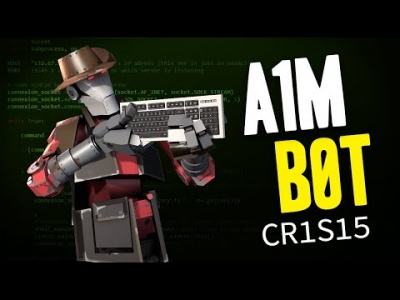
Starting in early 2020, a phenomenon colloquially referred to as the “TF2 Bot Crisis” began to unfold within the game[21]. This event was characterized by a rapid influx of malicious bots on the official Valve TF2 servers that wreaked many forms of havoc with the event currently still ongoing. Bots (short for robots) are automated computer programs that use artificial intelligence to more efficiently perform specific tasks[22], which in the case of TF2 is largely to disrupt gameplay, propagate hate speech, and ruin players’ experiences[21]. These types of bots started appearing in TF2 servers as early as 2017 but were largely an uncommon sight in games[21]. The main proliferation of bots occurred in early 2020, resulting in circumstances in which encountering multiple malicious bots in a given match became a norm[21]. Bots were written by individuals with expertise in coding who had malicious intents within the game[23]. Many developers of TF2 bot software publish their bot programs online, which allows script kiddies [24] to download and use the cheating software[21].
Types of Bots
There are several types of activities that bots can perform, and they are not incapable of carrying out multiple of these at once.
- Aimbots
- Aimbots commonly exploit the game’s Sniper class and the strength of artificial intelligence to instantly kill other players in mere fractions of a second, an amount of time that is nearly impossible for authentic, human players to respond to[21].
- Spambots
- Spambots abuse the in-game text chat feature to disseminate hate speech targeting several commonly targeted groups in high volumes[21][23]. The detriment of this bot spamming is two-fold, as the in-game chat box also becomes virtually unusable for actual players to communicate with due to the inordinate amount of hate speech clogging it.
- Micbots
- Micbots operate similarly to spambots with the key difference being that they instead take advantage of the in-game voice chat feature to relay offensive messages or songs at full volume[21]. Again, comparable to spambots, micbots effectively disrupt the ability for actual players to communicate over the in-game voice chat feature, in addition to the vocalized hate-speech.
- Kickbots
- These bots are notorious for joining a game, changing their username to that of another player in the same, and then starting a vote to kick the original human player in hopes that other human players mistakenly take the human player to be the bot and vote to kick him or her out of the game instead of the bot[21].
- Lagbots
- These bots take advantage of game system vulnerabilities related to the game’s player cosmetics system to cause lag-related issues on a server, sometimes even to the point of lagging out the server completely, causing the current game to stop abruptly[25].
Valve's Response
Valve has been largely absent on the matter of bots within the game as very little has been done to combat bots through updates to the game. History has shown that Valve seems to not even acknowledge that there is a bot problem or show plans to fight back against them[21].
Player's Response
Players have the capability to counter spambots and micbots by muting their in-game voices and chat abilities, but this only applies to the individual player who does this. Additionally, the frequency of bots and the haphazard manner in which they join and leave matches makes performing these counteractions become a tireless chore for players[21]. The only weapon that authentic players currently have against bots is the in-game voting mechanism. With it, players can start a vote with the intention to kick another player on their team. If a majority votes in favor, then that player will be kicked. While this does enable the ability for genuine players to boot out undesirable bots, the bots have many ways of circumventing these kick votes, such as leaving the game before the vote finishes and rejoining or by simply having enough other bots in the game that vote against kicking fellow bots so that the majority vote doesn’t go through[21]. Some enterprising individuals in the TF2 community with coding expertise and the intent to combat the bots have developed anti-bot software to kill bots within the game, which recognize and automatically start kick votes on bots before they grow too large in numbers. [23]
Hindrance to Gameplay
The many techniques employed by bots to ruin the gameplay experience for players have resulted in dissatisfaction in fanbase[21]. Numerous forums, discussion threads, and videos lament the current state of the game caused by the relentless presence of malicious bots that prevent players from having an enjoyable gameplay experience[21].
Medium for Hate Speech
The abuse of in-game text and voice channels by bots also allow for them to troll and harass other players by propagating racist, homophobic, transphobic, sexist, anti-Semitic, and other unflattering speech in ways that cannot be easily regulated or prevented[21].
Reflection of Valve
Despite the bot crisis raging on in one of its games, Valve has largely remained quiet on the entire situation and has taken very little tangible action against the bots aside from some small attempts to minimize the hate speech in the in-game chat[26]. One player named Jason Hughes feels it is unethical behavior for Valve to continue making a profit from its in-game market while the bot problem persists as it makes TF2 a game that is barely playable anymore among its players[21].
See Also
External Links
References
- ↑ "Orange Box" https://store.steampowered.com/sub/469/
- ↑ Team Fortress http://www.teamfortress.com
- ↑ http://www.metacritic.com/game/pc/team-fortress-2
- ↑ http://www.gamerankings.com/pc/437678-team-fortress-2/index.html
- ↑ http://www.1up.com/games/pc/team-fortress-2/
- ↑ "MMORPG" https://www.techopedia.com/definition/1919/massively-multiplayer-online-role-playing-game-mmorpg
- ↑ http://en.wikipedia.org/wiki/Team_Fortress_2
- ↑ "Team Fortress Classic" https://store.steampowered.com/app/20/Team_Fortress_Classic/
- ↑ http://en.wikipedia.org/wiki/Team_Fortress_Classic
- ↑ http://www.planetfortress.com/tfc/guide/introduction.shtml
- ↑ http://www.gamespot.com/team-fortress-2/
- ↑ http://en.wikipedia.org/wiki/Team_Fortress_2
- ↑ "Classes" https://teamfortress.fandom.com/
- ↑ https://support.steampowered.com/kb_article.php?ref=5406-WFZC-5519
- ↑ https://support.steampowered.com/kb_article.php?ref=7849-Radz-6869
- ↑ http://forums.steampowered.com/forums/showthread.php?t=1385172
- ↑ SteamRep Forums
- ↑ Shoot to Kill: The Real Impact of Violent Video Games, Bamford, Art, 28 July 2014 https://fulleryouthinstitute.org/blog/viamedia-shoot-to-kill
- ↑ "Flaming" https://cnalifestyle.channelnewsasia.com/trending/online-gaming-flaming-sexism-trolls-12782526
- ↑ [Toofty]. (2020, Jan 10). The TF2 Aimbot Crisis [Video]. YouTube. https://www.youtube.com/watch?v=4JBFTHNztDs
- ↑ 21.00 21.01 21.02 21.03 21.04 21.05 21.06 21.07 21.08 21.09 21.10 21.11 21.12 21.13 21.14 21.15 Conditt, J. (2020, June 5). Valve is allowing racist bots to invade ‘Team Fortress 2.’ Engadget. https://www.engadget.com/tf2-racist-bots-valve-problem-interview-steam-194444105.html
- ↑ Gillis, A. S. (2020, Jan). Definition: bot (robot). WhatIs. https://whatis.techtarget.com/definition/bot-robot
- ↑ 23.0 23.1 23.2 Franceschi-Bicchierai, L. (2020, Oct 13). Meet the Guy Fixing Team Fortress 2's Bot Problem...With More Bots. Vice. https://www.vice.com/en/article/n7w87d/meet-the-guy-fixing-team-fortress-2s-bot-problemwith-more-bots
- ↑ TechTarget Contributor. (2007, June). Definition: script kiddy (or script kiddie). WhatIs. https://searchsecurity.techtarget.com/definition/script-kiddy-or-script-kiddie
- ↑ Wilde, T. (2020, April 7). Team Fortress 2 is under attack by bots, and not the fun kind (Updated). PC Gamer. https://www.pcgamer.com/team-fortress-2-is-under-attack-by-bots-and-not-the-fun-kind/
- ↑ TF2 Team. (2020, July 3). Team Fortress 2 Update Released. Team Fortress 2. https://www.teamfortress.com/post.php?id=63061
